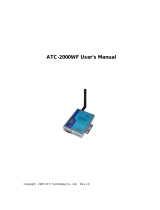
Contents
Apply Defaults _____________________________________________________ 41
5: Configuration via Serial Mode or Telnet Port 42
Accessing Setup Mode _______________________________________________ 42
Telnet Access __________________________________________________________ 42
Serial Port Access ______________________________________________________ 43
Server Configuration _________________________________________________ 44
Network Mode (MatchPort b/g Only) ________________________________________ 44
Set the IP Address ______________________________________________________ 44
Set the Gateway IP Address ______________________________________________ 45
Set the Netmask ________________________________________________________ 45
Set DNS Server IP Address _______________________________________________ 45
Change Telnet Configuration Password ______________________________________ 45
DHCP Name __________________________________________________________ 46
Channel 1 and Channel 2 Configuration _________________________________ 46
Baudrate ______________________________________________________________ 47
I/F (Interface) Mode _____________________________________________________ 47
Flow _________________________________________________________________ 48
Port Number ___________________________________________________________ 48
Connect Mode _________________________________________________________ 49
Send the Escape Sequence (+++) in Modem Mode _____________________________ 56
Show IP addr after 'RING' ________________________________________________ 56
Auto Increment Source Port _______________________________________________ 56
Remote IP Address _____________________________________________________ 57
Remote Port ___________________________________________________________ 57
DisConnMode _________________________________________________________ 57
Flush Mode ___________________________________________________________ 58
DisConnTime (Inactivity Timeout) __________________________________________ 60
SendChar 1 and SendChar 2 ______________________________________________ 60
Telnet Terminal Type ____________________________________________________ 60
Channel (Port) Password _________________________________________________ 60
Email Configuration _________________________________________________ 60
Mail Server ____________________________________________________________ 62
Unit Name ____________________________________________________________ 62
Domain Name _________________________________________________________ 62
Recipients ____________________________________________________________ 62
Triggers ______________________________________________________________ 62
WLAN Settings (MatchPort b/g Only) ____________________________________ 63
Topology _____________________________________________________________ 64
Network Name (SSID) ___________________________________________________ 64
Adhoc Network Channel __________________________________________________ 64
Security Suite __________________________________________________________ 64
WEP _________________________________________________________________ 65
WPA _________________________________________________________________ 66
802.11i/WPA2-Personal __________________________________________________ 66
Fixed or Automatic Data Rate _____________________________________________ 67
Transmission Data Rate __________________________________________________ 67
Minimum TX Data Rate __________________________________________________ 67
MatchPort User Guide 6

























